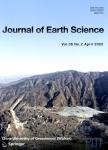版权所有:内蒙古大学图书馆 技术提供:维普资讯• 智图
内蒙古自治区呼和浩特市赛罕区大学西街235号 邮编: 010021

作者机构:School of Environmental Studies, China University of Geosciences State Key Laboratory of Biogeology and Environmental Geology, China University of Geosciences Hubei Key Laboratory of Yangtze Catchment Environmental Aquatic Science, China University of Geosciences State Environmental Protection Key Laboratory of Source Apportionment and Control of Aquatic Pollution, Ministry of Ecology and Environment, China University of Geosciences(Wuhan)
出 版 物:《Journal of Earth Science》 (地球科学学刊)
年 卷 期:2025年
核心收录:
学科分类:0709[理学-地质学] 070901[理学-矿物学、岩石学、矿床学] 07[理学] 09[农学] 0903[农学-农业资源与环境] 0713[理学-生态学]
基 金:supported by the National Key Research and Development Program of China (2018YFA0901303) National Natural Science Foundation of China (42272353,42277065) the Fundamental Research Funds for the Central Universities,China University of Geosciences (Wuhan)(No 122-G1323533057)
摘 要:Electron shuttles are widespread in the environments and play important role in microbe-mineral interaction. This study investigated the effects of a model electron shuttle (i.e., anthraquinone-2, 6-disulfonate, AQDS) on Shewanella oneidensis MR-1-mediated Fenton reaction and subsequent degradation of 2, 2′, 4, 4′-tetrabrominated diphenyl ether (BDE-47). Three Fe(III)-containing minerals, namely, ferrihydrite, goethite and nontronite, were used as electron acceptors and Fe(II) sources. With each mineral, additions of 0.01 – 1 mM AQDS in the reactions significantly enhanced Fe(III) reduction by S. oneidensis MR-1 and increased the amounts of Fe(II) produced in anoxic phase. As a result, the amounts of cumulative ·OH formed in oxic phase were increased by 10% – 287%. Regression analysis revealed that ·OH cumulation has significant linear correlation with sorbed Fe(II) but not aqueous and structural Fe(II). This finding may be ascribed to the higher reactivity of sorbed Fe(II) in oxygenation than the latter two types of Fe(II). With more ·OH, the degradation efficiency of BDE-47 was elevated by 31% – 173%. Collectively, AQDS enhances ·OH formation and BDE-47 degradation by promoting production of Fe(II), particularly sorbed Fe(II) in S. oneidensis MR-1-mediated Fenton reaction with Fe(III)-containing minerals.